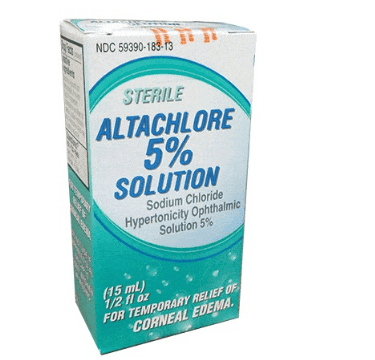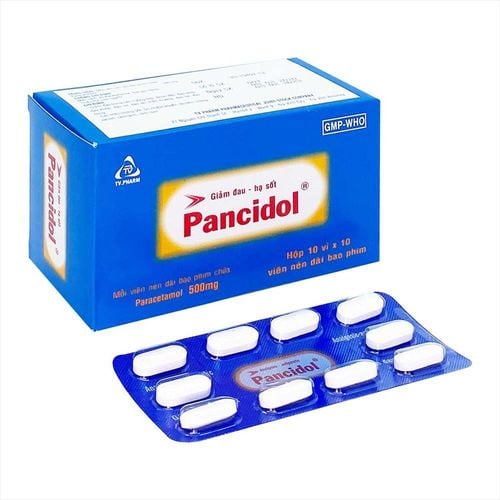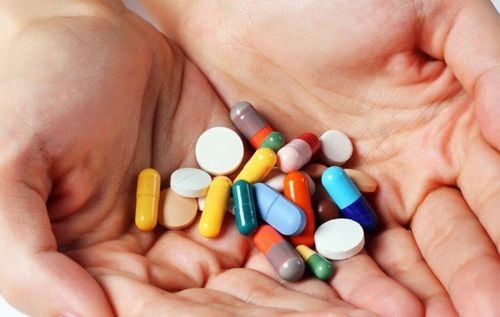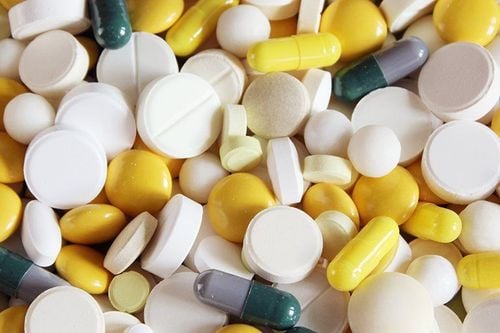This is an automatically translated article.
Drug fever may be the only manifestation of an adverse drug reaction. The risk of developing drug-induced fever increases with the amount of medication prescribed, especially in elderly patients. Accordingly, the recognition of fever caused by drugs as well as drugs that cause fever is clinically important. Otherwise the condition will have undesirable consequences, including further testing, unnecessary treatment, and prolonged hospital stay.1. What is drug fever?
Drug fever is a disorder characterized by a febrile response, concomitant with the use of drugs in the absence of underlying conditions that may have caused the fever. The main feature that distinguishes drug-induced fever from fever from other causes is that it usually disappears after the drug is discontinued.
Drug fever should be classified as a diagnosis of exclusion, usually suspected in patients with unexplained fever. It is important for the clinician to be aware of the potential for drug fever and the most common pyrogens to avoid additional diagnostic and therapeutic costs and extended hospital stays.
2. Drugs that can cause fever
Groups of antibiotics that can cause fever such as:
Penicillins group: ampicillin, carbenicillin, cloxacillin, mezlocillin, nafcillin, oxacillin, penicillin, piperacillin, staphcillin, ticarcillin Cephalosporins group: cefazolin, cefotaxime, ceftazidime, cephalexin, Other groups: acyclovir, amphotericin B, aureomycin, declomycin, erythromycin, furadantin, isoniazid, minocycline, nitrofurantoin, novobiocin, rifampin, streptomycin, terramycin, tetracycline, trimethoprim-sulfamethoxazole, vancomycin, Immunosuppressants, everphenolatemus, mycotinol:azathioprine sirolimus Inhibitors of neoplasia:mercaptupurine, bleomycin, chlorambucil, cisplatin, cytosine arabinoside, daunorubicin, hydroxyurea, interferon, L-asparaginase, procarbazine, streptozocin, vincristine Cardiovascular drugs: clofibrate, diltiazem, dobutamine, furosemide, heparin, furosemide oxprenolol, procainamide, quinidine and quinine, triameterene NSAID pain relievers: ibuprofen, napro Xen, tolmetin Sympathomimetic agents: amphetamine, lysergic acid, methylene dioxymethamphetamine Antiepileptic drugs: arbamazepine, phenytoin Other drugs: allopurinol, cimetidine, folate, iodide, mebendazole, metoclopramide, piperazine adipate, propylthiouracil, prostaglandin, ritodine sulfasalazine, theophylline, thyroxine Antidepressants: doxepin, nomifensine
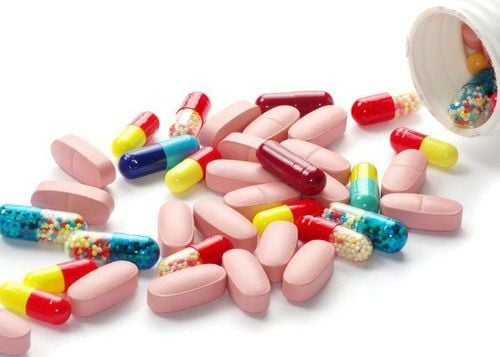
Một số nhóm thuốc kháng sinh có thể gây ra tình trạng sốt.
3. How to diagnose drug fever?
The key to diagnosing drug fever is to consider the condition in any patient without another cause of fever, especially when fever does not correspond to the possibility of infection.
Diagnosis is often difficult and should be made after careful assessment of the patient's clinical presentation, drug therapy, and laboratory values. Antipyretics should be considered in the differential diagnosis of fever in many patients, especially those taking drugs that are strongly associated with drug-induced fever.
In fact, the first assumption made by most clinicians is to seek or treat a fever suspected of being infectious, a regimen that is reasonable but can lead to overuse of antibiotics. Because fever can also be a feature of many pathogenesis other than infection, including malignancy, thromboembolic disease, cerebrovascular accident, collagen vascular disease, acute gout, surgery, and trauma love.
4. Clinical features of drug-induced fever
Drug fever can occur at any time during drug treatment and varies considerably between different classes of drugs. The average time from the start of the antipyretic to the onset of fever was 7–10 days. Moreover, this time is also very variable and depends on different drug classes.
Besides, fever patterns can also be different in patients with drug-induced fever, varying from persistent fever (temperature varies but always rises above normal), intermittent fever (interrupted by heat) normal) and high fever (which is a combination of intermittent and intermittent fever patterns). Among them, typhus is the most common manifestation.
On the other hand, the degree of fever can also vary, from a mild fever with a temperature of 37.2°C to a temperature as high as 42.7°C, but a body temperature between 38.8 - 40°C is most common.
Another sign that points to possible drug fever is bradycardia. In addition, skin hypersensitivity manifestations have also been observed in patients with drug-induced fever such as urticaria with or without petechiae. However, skin manifestations are not common, so the diagnosis of drug fever cannot be excluded.
In particular, patients can also have a febrile reaction to the drug even after stopping the drug, as well as a rash or other clinical manifestations.

Sốt phát ban là biểu hiện phổ biến nhất của sốt do thuốc.
5. Subclinical features of drug-induced fever
Tests may be helpful in assisting in the diagnosis of drug-induced fever, although the results are variable and cannot be relied upon for a definitive diagnosis.
In which, the physician needs to perform a differential white blood cell count assessment for all patients with suspected drug fever. Results may be leukocytosis and with or without left shift. The detection of febrile leukocytosis should guide clinicians to reassess infection control. The relative prevalence of eosinophils is frequently elevated but true eosinophilia is inherently less common.
Besides, the erythrocyte sedimentation rate can also be high, sometimes up to 100 mm/hr or higher, but values in the range of 40–60 mm/hr are more common. In blood chemistry, liver transaminase levels may be slightly elevated, however, this result is usually no more than 2 times the upper limit of normal in about 90% of patients. Lactic dehydrogenase levels may also be elevated, but a normal value does not rule out drug-induced fever.
In general, no laboratory test is useful in diagnosing drug-induced febrile conditions. The demonstration of antibodies to the drug by serology or skin testing is not helpful, as they often develop in asymptomatic patients with a lack of clinical hypersensitivity.
6. How to treat patients with drug fever
The most reasonable approach to treating drug-induced fever is to discontinue the drug that causes the fever. Identifying the appropriate agent can be challenging and there is no standard approach. Depending on the severity of the accompanying reaction, your doctor may recommend discontinuing all suspected drugs, those recently added, or all unnecessary medications.
In case of fever without signs of hypersensitivity, the patient can stop taking a recently added drug or a drug with high suspicion. After discontinuation of use, fever usually improves within 48-72 hours, although it can sometimes persist for days to weeks if other hypersensitivity manifestations are accompanied by fever such as maculopapular rash or if the rate of elimination of fever-causing drugs from the body is slow.
In this context, discontinuation of the drug should be considered with caution, as the benefits of continuing treatment may outweigh the risk of continued fever in some clinical situations. Once the fever is under control, medication can be reintroduced judiciously, one at a time, and avoiding the most highly suspected drugs if possible.
In short, the body maintains body temperature within a narrow range. Taking medication can upset the normal balance and cause a fever. However, fever can be caused by the pharmacological action of the drug or by some other unrelated effect, but if drug fever occurs most often after 7 to 10 days of taking the drug, persists with continued dosing, and disappears. immediately after stopping the drug and will quickly reappear if the drug is continued. Therefore, caution should be exercised when using drugs that cause fever and should be replaced with equivalent drugs if available.
Therefore, before using any medicine, patients should talk to their doctor or pharmacist to be prescribed a suitable and healthy drug.
Vinmec International General Hospital is always the address to receive and solve all health problems for all patients. Therefore, when there are diseases, customers can contact the hospital for the best advice and care.
Please dial HOTLINE for more information or register for an appointment HERE. Download MyVinmec app to make appointments faster and to manage your bookings easily.
References: uptodate.com - pubmed.ncbi.nlm.nih.gov





